Raiko is a Japanese satellite which was built and operated by Tohoku and Wakayama Universities. A two-unit CubeSat, Raiko was deployed from the International Space Station on October 4, 2012, having been launched in July.
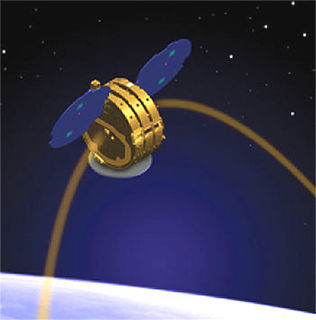
TacSat-1 was an experimental satellite built by the Naval Research Laboratory on behalf of the United States Department of Defense (DOD) Office of Force Transformation (OFT). The second satellite in the series, TacSat-2, has already been launched. It was the planned payload of the sixth launch of the SpaceX Falcon 1.
MightySat-2.1, also known as P99-1 or Sindri was a small spacecraft developed by the Air Force Research Laboratory to test advanced technologies in imaging, communications, and spacecraft bus components in space.
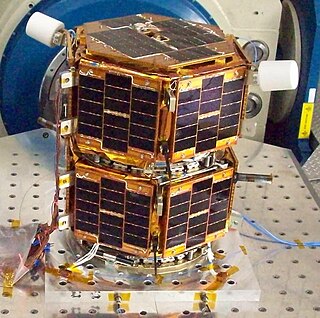
Formation Autonomy Spacecraft with Thrust, Relnav, Attitude and Crosslink is a pair of nanosatellites developed and built by students at The University of Texas at Austin. The project is part of a program sponsored by the Air Force Research Laboratory (AFRL), whose goal is to lead the development of affordable space technology. The FASTRAC mission will specifically investigate technologies that facilitate the operation of multiple satellites in formation. These enabling technologies include relative navigation, cross-link communications, attitude determination, and thrust. Due to the high cost of lifting mass into orbit, there is a strong initiative to miniaturize the overall weight of spacecraft. The utilization of formations of satellites, in place of large single satellites, reduces the risk of single point failure and allows for the use of low-cost hardware.

Earth Observing-1 (EO-1) is a decommissioned NASA Earth observation satellite created to develop and validate a number of instrument and spacecraft bus breakthrough technologies. It was intended to enable the development of future Earth imaging observatories that will have a significant increase in performance while also having reduced cost and mass. The spacecraft was part of the New Millennium Program. It was the first satellite to map active lava flows from space; the first to measure a facility's methane leak from space; and the first to track re-growth in a partially logged Amazon forest from space. EO-1 captured scenes such as the ash after the World Trade Center attacks, the flooding in New Orleans after Hurricane Katrina, volcanic eruptions and a large methane leak in southern California.
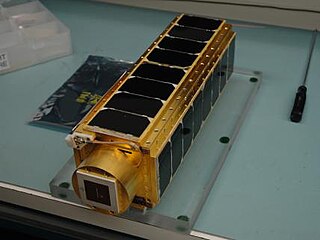
PharmaSat was a nanosatellite developed by NASA Ames Research Center which measured the influence of microgravity upon yeast resistance to an antifungal agent. As a follow on to the GeneSat-1 mission, the Ames Small Spacecraft Division conducted the PharmaSat mission in collaboration with industry and local universities.
AeroCube 3 is a single-unit CubeSat which was built and is being operated by The Aerospace Corporation. It is the third AeroCube satellite, following on from AeroCube 1, which was lost in a launch failure in 2006, and AeroCube 2 which was successfully launched in 2007 but failed immediately after launch. Compared to its predecessors it contains several improvements in its infrastructure, including a redesigned power system, replacing the older system which was responsible for the loss of AeroCube 2. Its development was funded by the United States Air Force Space and Missile Systems Center.
CP6, also known as PolySat-6, PolySat CP-6 or CalPoly 6 is a single-unit CubeSat which was built and operated by the California Polytechnic State University. It was primarily intended to perform a technology demonstration mission. The main experiment consisted of sensors to determine the spacecraft's attitude. Cameras on the satellite will be used to verify the data returned by the attitude sensors. Originally built as a backup to CP3, which was launched in April 2007, CP6 was modified after it was decided that it would no longer be needed for that role.
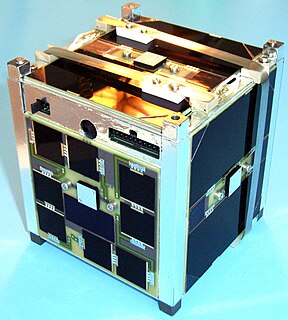
BeeSat-1 or Berlin Experimental and Educational Satellite 1, is a German satellite operated by the Technical University of Berlin. The spacecraft is a single unit CubeSat, which was designed to test systems intended for use on future spacecraft, including a new design of reaction wheel. It has also been used for amateur radio, and is equipped with a small camera.
KySat-1 was an American satellite which was to have been operated by Kentucky Space. Designed to operate for eighteen to twenty four months, it was lost in a launch failure in March 2011 after the Taurus rocket carrying it failed to achieve orbit.
Hermes was an American satellite which was to have been operated by the Colorado Space Grant Consortium. Intended to perform technology demonstration experiments in low Earth orbit, it was lost during launch in March 2011 when the rocket that was carrying it failed to achieve orbit.
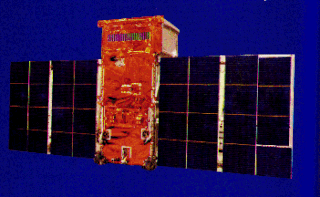
TD-1A, or Thor-Delta 1A, was a European astrophysical research satellite which was launched in 1972. Operated by the European Space Research Organisation, TD-1A made astronomical surveys primarily in the ultraviolet, but also using x-ray and gamma ray detectors.

SpaceX CRS-4, also known as SpX-4, was a Commercial Resupply Service mission to the International Space Station, contracted to NASA, which was launched on 21 September 2014 and arrived at the space station on 23 September 2014. It was the sixth flight for SpaceX's uncrewed Dragon cargo spacecraft, and the fourth SpaceX operational mission contracted to NASA under a Commercial Resupply Services contract. The mission brought equipment and supplies to the space station, including the first 3D printer to be tested in space, a device to measure wind speed on Earth, and small satellites to be launched from the station. It also brought 20 mice for long-term research aboard the ISS.

Progress MS-02, identified by NASA as Progress 63 or 63P, is a Progress spacecraft used by Roscosmos to resupply the International Space Station (ISS) during 2016. It was launched on March 31, 2016, to deliver cargo to the ISS.
The JSAT constellation is a communication and broadcasting satellite constellation formerly operated by JSAT Corporation and currently by SKY Perfect JSAT Group. It has become the most important commercial constellation in Japan, and fifth in the world. It has practically amalgamated all private satellite operators in Japan, with only B-SAT left as a local competitor.
PicoDragon is a small satellite that followed the 1U of CubeSat program built by Vietnam National Satellite Center belong to VAST and operated in space for 3 months.

ASTERIA is a miniaturized space telescope meant as a technology demonstrator to advance the capabilities for astrophysical measurements. Its bus is a nanosatellite of the 6U CubeSat format. It was designed in collaboration between the Massachusetts Institute of Technology (MIT) and NASA's Jet Propulsion Laboratory.










